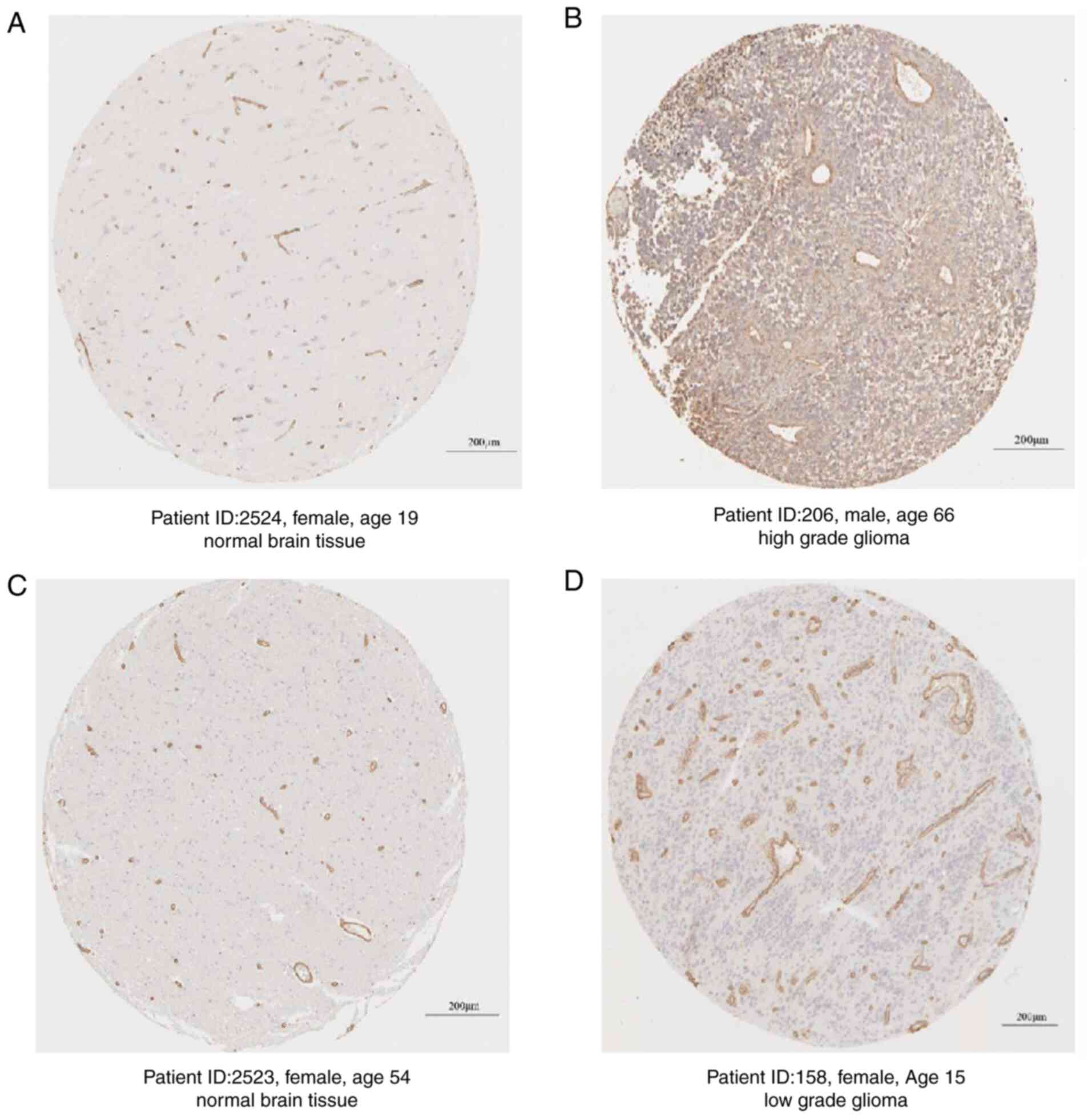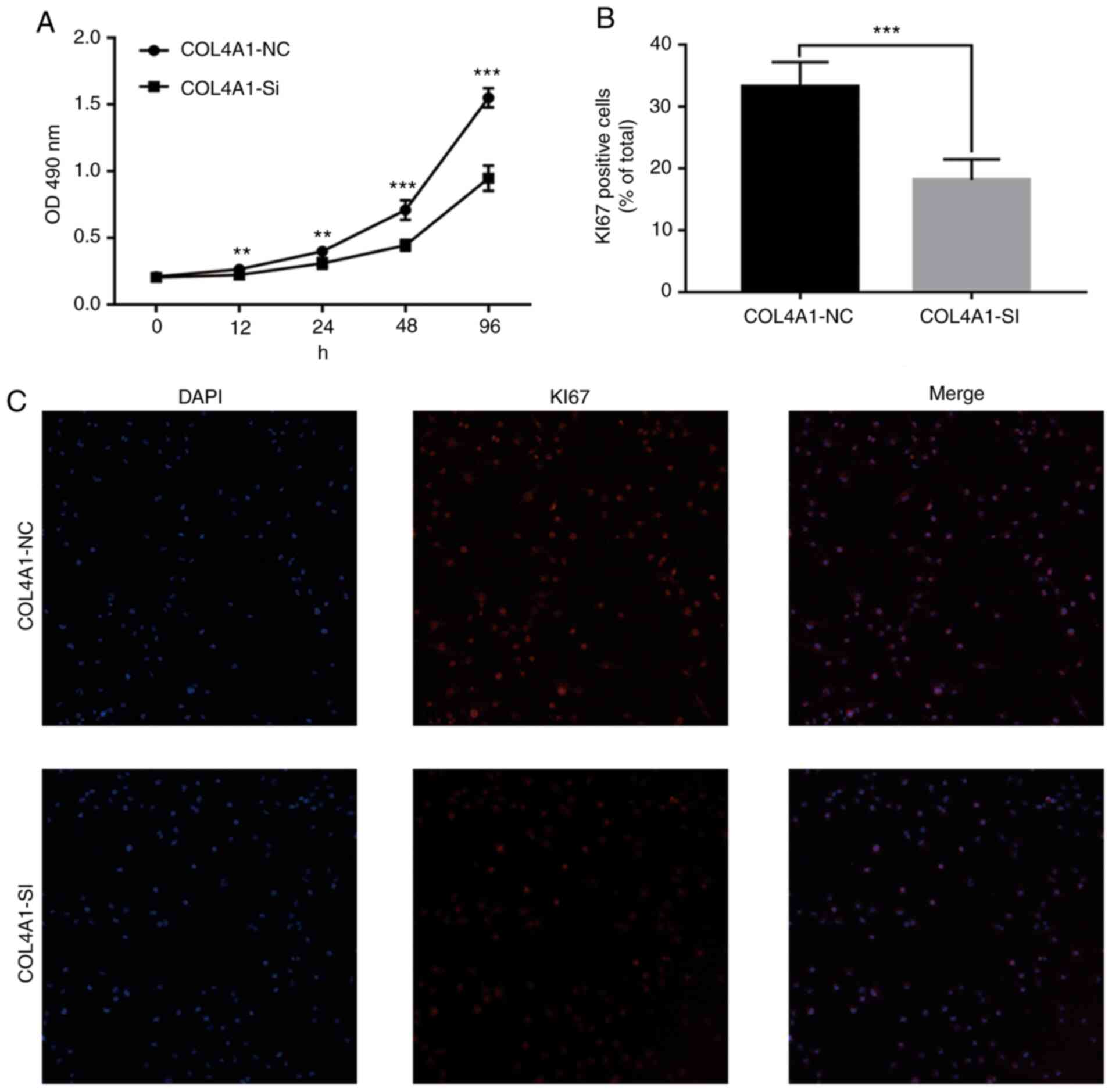|
1
|
Ostrom QT, Gittleman H, Farah P, Ondracek
A, Chen Y, Wolinsky Y, Stroup NE, Kruchko C and Barnholtz-Sloan JS:
CBTRUS statistical report: Primary brain and central nervous system
tumors diagnosed in the United States in 2006-2010. NeuroOncol. 15
(Suppl 2):ii1–ii56. 2013.PubMed/NCBI View Article : Google Scholar
|
|
2
|
Ohgaki H and Kleihues P: Epidemiology and
etiology of gliomas. Acta Neuropathol. 109:93–108. 2005.PubMed/NCBI View Article : Google Scholar
|
|
3
|
Ostrom QT, Bauchet L, Davis FG, Deltour I,
Fisher JL, Langer CE, Pekmezci M, Schwartzbaum JA, Turner MC, Walsh
KM, et al: The epidemiology of glioma in adults: A ‘state of the
science’ review. Neuro Oncol. 16:896–913. 2014.PubMed/NCBI View Article : Google Scholar
|
|
4
|
Claus EB and Black PM: Survival rates and
patterns of care for patients diagnosed with supratentorial
low-grade gliomas: Data from the SEER program, 1973-2001. Cancer.
106:1358–1363. 2006.PubMed/NCBI View Article : Google Scholar
|
|
5
|
Yang P, Wang Y, Peng X, You G, Zhang W,
Yan W, Bao Z, Wang Y, Qiu X and Jiang T: Management and survival
rates in patients with glioma in China (2004-2010): A retrospective
study from a single-institution. J Neurooncol. 113:259–266.
2013.PubMed/NCBI View Article : Google Scholar
|
|
6
|
Delgado-López PD and Corrales-García EM:
Survival in glioblastoma: A review on the impact of treatment
modalities. Clin Transl Oncol. 18:1062–1071. 2016.PubMed/NCBI View Article : Google Scholar
|
|
7
|
Omuro A and DeAngelis LM: Glioblastoma and
other malignant gliomas: A clinical review. JAMA. 310:1842–1850.
2013.PubMed/NCBI View Article : Google Scholar
|
|
8
|
Lohr J, Ratliff T, Huppertz A, Ge Y,
Dictus C, Ahmadi R, Grau S, Hiraoka N, Eckstein V, Ecker RC, et al:
Effector T-cell infiltration positively impacts survival of
glioblastoma patients and is impaired by tumor-derived TGF-β. Clin
Cancer Res. 17:4296–4308. 2011.PubMed/NCBI View Article : Google Scholar
|
|
9
|
Murat A, Migliavacca E, Gorlia T, Lambiv
WL, Shay T, Hamou MF, de Tribolet N, Regli L, Wick W, Kouwenhoven
MC, et al: Stem cell-related ‘self-renewal’ signature and high
epidermal growth factor receptor expression associated with
resistance to concomitant chemoradiotherapy in glioblastoma. J Clin
Oncol. 26:3015–3024. 2008.PubMed/NCBI View Article : Google Scholar
|
|
10
|
Hale JS, Otvos B, Sinyuk M, Alvarado AG,
Hitomi M, Stoltz K, Wu Q, Flavahan W, Levison B, Johansen ML, et
al: Cancer stem cell-specific scavenger receptor CD36 drives
glioblastoma progression. Stem Cells. 32:1746–1758. 2014.PubMed/NCBI View Article : Google Scholar
|
|
11
|
Pollner R, Schmidt C, Fischer G, Kühn K
and Pöschl E: Cooperative and competitive interactions of
regulatory elements are involved in the control of divergent
transcription of human Col4A1 and Col4A2 genes. FEBS Lett.
405:31–36. 1997.PubMed/NCBI View Article : Google Scholar
|
|
12
|
Yurchenco PD: Basement membranes: Cell
scaffoldings and signaling platforms. Cold Spring Harb Perspect
Biol. 3(a004911)2011.PubMed/NCBI View Article : Google Scholar
|
|
13
|
Labelle-Dumais C, Schuitema V, Hayashi G,
Hoff K, Gong W, Dao DQ, Ullian EM, Oishi P, Margeta M and Gould DB:
COL4A1 mutations cause neuromuscular disease with tissue-specific
mechanistic heterogeneity. Am J Hum Genet. 104:847–860.
2019.PubMed/NCBI View Article : Google Scholar
|
|
14
|
Jin R, Shen J, Zhang T, Liu Q, Liao C, Ma
H, Li S and Yu Z: The highly expressed COL4A1 genes contributes to
the proliferation and migration of the invasive ductal carcinomas.
Oncotarget. 8:58172–58183. 2017.PubMed/NCBI View Article : Google Scholar
|
|
15
|
Kitzler TM, Schneider R, Kohl S,
Kolvenbach CM, Connaughton DM, Dai R, Mann N, Nakayama M, Majmundar
AJ, Wu CW, et al: COL4A1 mutations as a potential novel cause of
autosomal dominant CAKUT in humans. Hum Genet. 138:1105–1115.
2019.PubMed/NCBI View Article : Google Scholar
|
|
16
|
Li F, Wang NN, Chang X, Wang SL, Wang LS,
Yao J, Li ZS and Bai Y: Bioinformatics analysis suggests that
COL4A1 may play an important role in gastric carcinoma recurrence.
J Dig Dis. 20:391–400. 2019.PubMed/NCBI View Article : Google Scholar
|
|
17
|
Lin S, Xia C, He S, Yang J, Li H, Zheng J,
Liu M and You C: Genetic variations of the COL4A1 gene and
intracerebral hemorrhage risk: A case-control study in a Chinese
han population. World Neurosurg. 112:e527–e533. 2018.PubMed/NCBI View Article : Google Scholar
|
|
18
|
Raza ST, Abbas S, Eba A, Karim F, Wani IA,
Rizvi S, Zaidi A and Mahdi F: Association of COL4A1 (rs605143,
rs565470) and CD14 (rs2569190) genes polymorphism with coronary
artery disease. Mol Cell Biochem. 445:117–122. 2018.PubMed/NCBI View Article : Google Scholar
|
|
19
|
Saskin A, Sillon G, Palfreeman N and Buhas
D: COL4A1/2 CNVs and cerebral small vessel disease: Narrowing in on
the critical chromosomal region. Neurology. 90:1026–1028.
2018.PubMed/NCBI View Article : Google Scholar
|
|
20
|
Chen FF, Zhang SR, Peng H, Chen YZ and Cui
XB: Integrative genomics analysis of hub genes and their
relationship with prognosis and signaling pathways in esophageal
squamous cell carcinoma. Mol Med Rep. 20:3649–3660. 2019.PubMed/NCBI View Article : Google Scholar
|
|
21
|
Pan Z, Li L, Fang Q, Zhang Y, Hu X, Qian Y
and Huang P: Analysis of dynamic molecular networks for pancreatic
ductal adenocarcinoma progression. Cancer Cell Int.
18(214)2018.PubMed/NCBI View Article : Google Scholar
|
|
22
|
Subramanian A, Kuehn H, Gould J, Tamayo P
and Mesirov JP: GSEA-P: A desktop application for gene set
enrichment analysis. Bioinformatics. 23:3251–3253. 2007.PubMed/NCBI View Article : Google Scholar
|
|
23
|
Livak KJ and Schmittgen TD: Analysis of
relative gene expression data using real-time quantitative PCR and
the 2(-Delta Delta C(T)) methods. Methods. 25:402–408.
2001.PubMed/NCBI View Article : Google Scholar
|
|
24
|
Wang SM, Chen PM, Sung YW, Huang WC, Huang
HS and Chu PY: Effect of COL4A1 expression on the survival of
neoadjuvant chemotherapy breast cancer patients. J Oncol.
2020(5209695)2020.PubMed/NCBI View Article : Google Scholar
|
|
25
|
Wang T, Jin H, Hu J, Li X, Ruan H, Xu H,
Wei L, Dong W, Teng F, Gu J, et al: COL4A1 promotes the growth and
metastasis of hepatocellular carcinoma cells by activating FAK-Src
signaling. J Exp Clin Cancer Res. 39(148)2020.PubMed/NCBI View Article : Google Scholar
|
|
26
|
Wu F, Li F, Lin X, Xu F, Cui RR, Zhong JY,
Zhu T, Shan SK, Liao XB, Yuan LQ and Mo ZH: Exosomes increased
angiogenesis in papillary thyroid cancer microenvironment. Endocr
Relat Cancer. 26:525–538. 2019.PubMed/NCBI View Article : Google Scholar
|
|
27
|
Jiang Y, He J, Guo Y, Tao H, Pu F and Li
Y: Identification of genes related to low-grade glioma progression
and prognosis based on integrated transcriptome analysis. J Cell
Biochem. 121:3099–3111. 2020.PubMed/NCBI View Article : Google Scholar
|
|
28
|
Miyake M, Morizawa Y, Hori S, Tatsumi Y,
Onishi S, Owari T, Iida K, Onishi K, Gotoh D, Nakai Y, et al:
Diagnostic and prognostic role of urinary collagens in primary
human bladder cancer. Cancer Sci. 108:2221–2228. 2017.PubMed/NCBI View Article : Google Scholar
|
|
29
|
Aboubakar Nana F, Vanderputten M and Ocak
S: Role of focal adhesion kinase in small-cell lung cancer and its
potential as a therapeutic target. Cancers (Basel).
11(1683)2019.PubMed/NCBI View Article : Google Scholar
|
|
30
|
Giaginis CT, Vgenopoulou S, Tsourouflis
GS, Politi EN, Kouraklis GP and Theocharis SE: Expression and
clinical significance of focal adhesion kinase in the two distinct
histological types, intestinal and diffuse, of human gastric
adenocarcinoma. Pathol Oncol Res. 15:173–181. 2009.PubMed/NCBI View Article : Google Scholar
|
|
31
|
Ozkal S, Paterson JC, Tedoldi S, Hansmann
ML, Kargi A, Manek S, Mason DY and Marafioti T: Focal adhesion
kinase (FAK) expression in normal and neoplastic lymphoid tissues.
Pathol Res Pract. 205:781–788. 2009.PubMed/NCBI View Article : Google Scholar
|
|
32
|
Ding L, Sun X, You Y, Liu N and Fu Z:
Expression of focal adhesion kinase and phosphorylated focal
adhesion kinase in human gliomas is associated with unfavorable
overall survival. Transl Res. 156:45–52. 2010.PubMed/NCBI View Article : Google Scholar
|
|
33
|
Chen Z, Morales JE, Guerrero PA, Sun H and
McCarty JH: PTPN12/PTP-PEST regulates phosphorylation-dependent
ubiquitination and stability of focal adhesion substrates in
invasive glioblastoma cells. Cancer Res. 78:3809–3822.
2018.PubMed/NCBI View Article : Google Scholar
|
|
34
|
Haskell H, Natarajan M, Hecker TP, Ding Q,
Stewart J Jr, Grammer JR and Gladson CL: Focal adhesion kinase is
expressed in the angiogenic blood vessels of malignant astrocytic
tumors in vivo and promotes capillary tube formation of brain
microvascular endothelial cells. Clin Cancer Res. 9:2157–2165.
2003.PubMed/NCBI
|
|
35
|
Ferrer VP, Moura Neto V and Mentlein R:
Glioma infiltration and extracellular matrix: Key players and
modulators. Glia. 66:1542–1565. 2018.PubMed/NCBI View Article : Google Scholar
|
|
36
|
Henrik Heiland D, Ravi VM, Behringer SP,
Frenking JH, Wurm J, Joseph K, Garrelfs NWC, Strähle J, Heynckes S,
Grauvogel J, et al: Tumor-associated reactive astrocytes aid the
evolution of immunosuppressive environment in glioblastoma. Nat
Commun. 10(2541)2019.PubMed/NCBI View Article : Google Scholar
|
|
37
|
Wang P, Peng X, Zhang J, Wang Z, Meng J,
Cen B, Ji A and He S: LncRNA-135528 inhibits tumor progression by
up-regulating CXCL10 through the JAK/STAT pathway. Apoptosis.
23:651–666. 2018.PubMed/NCBI View Article : Google Scholar
|
|
38
|
Xu CH, Liu Y, Xiao LM, Chen LK, Zheng SY,
Zeng EM, Li DH and Li YP: Silencing microRNA-221/222 cluster
suppresses glioblastoma angiogenesis by suppressor of cytokine
signaling-3-dependent JAK/STAT pathway. J Cell Physiol.
234:22272–22284. 2019.PubMed/NCBI View Article : Google Scholar
|
|
39
|
Zhang P, Chen FZ, Jia QB and Hu DF:
Upregulation of microRNA-133a and downregulation of connective
tissue growth factor suppress cell proliferation, migration, and
invasion in human glioma through the JAK/STAT signaling pathway.
IUBMB Life. 71:1857–1875. 2019.PubMed/NCBI View Article : Google Scholar
|
|
40
|
Hu F, Dzaye O, Hahn A, Yu Y, Scavetta RJ,
Dittmar G, Kaczmarek AK, Dunning KR, Ricciardelli C, Rinnenthal JL,
et al: Glioma-derived versican promotes tumor expansion via
glioma-associated microglial/macrophages Toll-like receptor 2
signaling. Neuro Oncol. 17:200–210. 2015.PubMed/NCBI View Article : Google Scholar
|
|
41
|
Wei L, Yi Z, Guo K and Long X: Long
noncoding RNA BCAR4 promotes glioma cell proliferation via
EGFR/PI3K/AKT signaling pathway. J Cell Physiol. 234:23608–23617.
2019.PubMed/NCBI View Article : Google Scholar
|



















